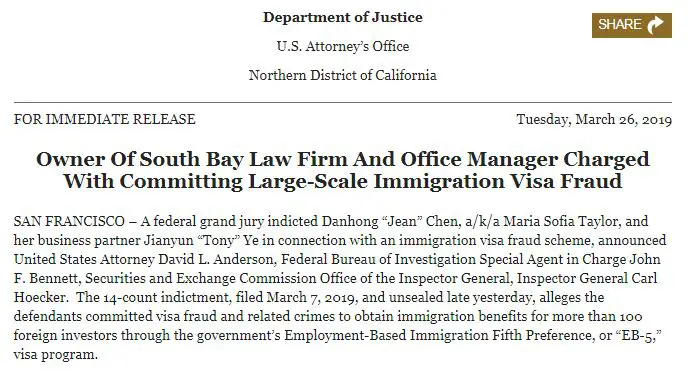U.S. Citizenship and Immigration Services (USCIS) is scheduled to publish a final rule tomorrow (07/24/2019) that will bring significant changes to the EB-5 Immigrant Investor Program. This controversial, money-for-green-card program hasn’t seen a major revision since 1993.
Starting Nov. 21, 2019:
- Minimum investment amounts will be raised from $1 million to $1.8 million, and adjusted for inflation every five years;
- Minimum investment for targeted employment areas (TEA) will increase from $500K to $900K.
- USCIS will take control in designating targeted employment areas (TEA);
- Certain derivative family members must apply independently to remove conditions on permanent residence; and
- Some EB-5 petitioners may retain their priority date when a new petition is filed.
Under the EB-5 program, individuals are eligible to apply for conditional lawful permanent residence (green card) in the United States if they make the necessary investment in the United States and create or, in certain circumstances, preserve 10 permanent full-time jobs for qualified U.S. workers.
Each year the EB-5 program allocates 10,000 visas for foreign investors and their family members, bringing in billions of dollars toward development projects in the U.S.
However, the EB-5 program has been plagued with widespread fraud and abuse for many years. News stories of sham projects and fake development popped up everywhere. Earlier this year, a high-profile immigration attorney in Northern California was charged with 14 counts by the Department of Justice in one of the largest EB-5 fraud cases in the country.
USCIS has been looking at ways to clean up the EB-5 program. After a multiyear effort, here comes the major overhaul:
Major changes to EB-5 in the final rule include:
Raising minimum investment amounts: As of the effective date of the final rule, the standard minimum investment level will increase from $1 million to $1.8 million, the first increase since 1990, to account for inflation. The rule also keeps the 50% minimum investment differential between a TEA and a non-TEA, thereby increasing the minimum investment amount in a TEA from $500,000 to $900,000. The final rule also provides that the minimum investment amounts will automatically adjust for inflation every five years.
TEA designation reforms: The final rule outlines changes to the EB-5 program to address gerrymandering of high-unemployment areas (which means deliberately manipulating the boundaries of an electoral constituency). Gerrymandering of such areas was typically accomplished by combining a series of census tracts to link a prosperous project location to a distressed community to obtain the qualifying average unemployment rate. As of the effective date of the final rule, DHS will eliminate a state’s ability to designate certain geographic and political subdivisions as high-unemployment areas; instead, DHS would make such designations directly based on revised requirements in the regulation limiting the composition of census tract-based TEAs. These revisions will help ensure TEA designations are done fairly and consistently, and more closely adhere to congressional intent to direct investment to areas most in need.
Clarifying USCIS procedures for removing conditions on permanent residence: The rule revises regulations to make clear that certain derivative family members who are lawful permanent residents must independently file to remove conditions on their permanent residence. The requirement would not apply to those family members who were included in a principal investor’s petition to remove conditions. The rule improves the adjudication process for removing conditions by providing flexibility in interview locations and to adopt the current USCIS process for issuing Green Cards.
Allowing EB-5 petitioners to keep their priority date: The final rule also offers greater flexibility to immigrant investors who have a previously approved EB-5 immigrant petition. When they need to file a new EB-5 petition, they generally now will be able to retain the priority date of the previously approved petition, subject to certain exceptions.

